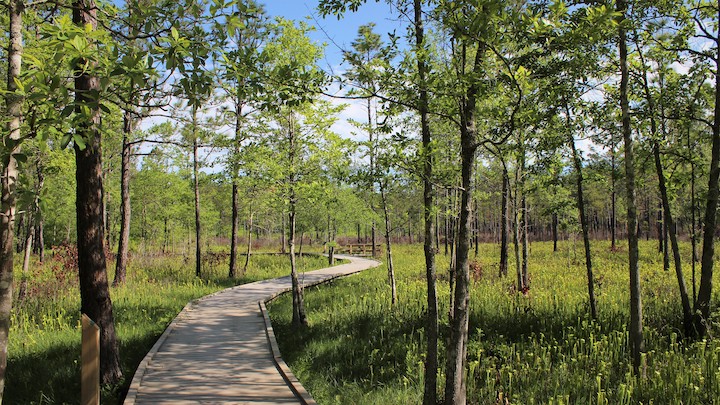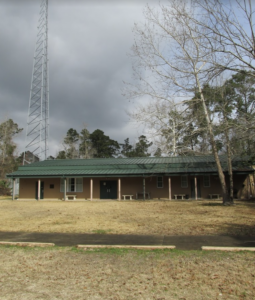This April we’re heading to Southeast Texas for a new project: Big Thicket National Preserve (BTNP). If you’re unfamiliar with Big Thicket National Preserve, let’s catch you up:
- BTNP was established on October 11, 1974
- BTNP less than 2 hours away from downtown Houston
- It’s the first National Preserve (shared with Big Cypress National Preserve in FL)
- BTNP consists of 113,114 acres
- Highest elevation: 318 feet
- Miles of waterway: 313 miles
- Miles of trails: 33 miles
- Average yearly rainfall: 55 inches
- Number of plant species: 1,320 (currently known)
- Number of endangered species: 3
There are 21 national preserves in the U.S. and they differ from national parks in that national preserves may allow hunting, mining, and fuel extraction, whereas national parks do not. Big Thicket National Preserve permits hunting and oil and gas extraction, however, these activities are managed by NPS staff to ensure that they “don’t affect the natural values for which the preserve was established.” Now that you know a little background about Big Thicket National Preserve, let’s get into the project details.
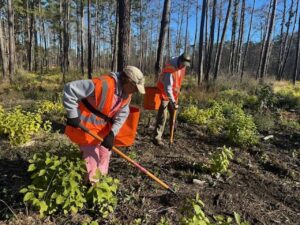 What does the project work consist of?
What does the project work consist of?
Within Thicket National Preserve you’ll find the iconic but imperiled longleaf pine savanna ecosystem: widely spaced pine trees and abundant grasses and wildflowers. BTNP is restoring several hundred acres of longleaf pine savanna and we’ll be planting native grasses in ongoing restoration sites.
Volunteers will rake and broadcast seed (100 lbs.) onto patches of soil throughout restoration areas that have been recently cleared of vegetation. Volunteers should be prepared to hike across uneven ground and use hand tools to cast the seeds. The project sites we’ll be working on are accessible by public and non-public roads but may require hiking up to 1/4 mile.
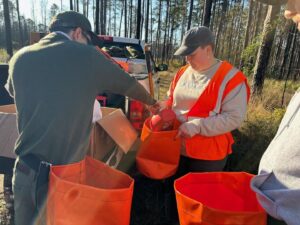 Why is this work important?
Why is this work important?
BTNP biologists indicated that getting this restoration area seeded is time-sensitive and an important step in the restoration process. Volunteers will provide the much-needed support and human power to accomplish this project.
What are the accommodations for this project?
We will be staying at the Field Research Station and Learning Center in Saratoga, TX during the project week. This facility includes a classroom, small laboratory, library, kitchen, dining area, showers, washer and dryer, and wifi.. We have two dormitories reserved (each can hold up to 10 men or 10 women) with a separate additional space for two people. We’re also working to secure additional sleeping space for the comfort of volunteers. Volunteers are welcome to car camp if preferred.
Who is a good fit for this project?
This is a great project for anyone new to Wilderness Volunteers, anyone who prefers projects rated active, or anyone who appreciates creature comforts.
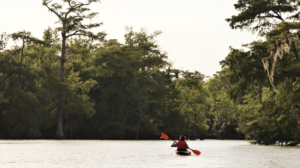 What is available to do on the day off?
What is available to do on the day off?
During the day off, volunteers can visit the preserve Visitor Center, hike trails, rent kayaks to paddle the waterways, etc. Additionally, the NPS is working to confirm a ranger-led paddle for interested volunteers. If volunteers are up for a road trip, they can visit McFaddin National Wildlife Refuge, San Houston National Forest, Beaumont, Port Arthur, or even cross the border into Louisiana.
It says that this is a hybrid project of volunteer and leader trainees. What does this mean?
Volunteers on the BTNP project may encounter and work with leader trainees practicing their skills with the supervision and guidance of two experienced project leaders. At this moment, there are no trainees, so this is a typical Wilderness Volunteers project.
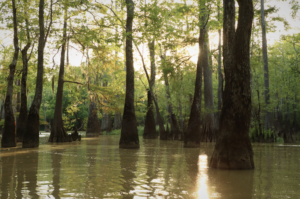 I’m interested in joining this project. What should I do?
I’m interested in joining this project. What should I do?
You can head to the 2025 Big Thicket National Preserve project page for more information. You can visit the NPS website for Big Thicket National Preserve here. If you have specific questions, please reach out to the Program Director, Aidalica Swertfeger, at aidalicia@wildernessvolunteers.org. We hope you join us!

